Genre: Maze Game Developer: Sega of Japan Publisher: Sega of Japan Players: 1 Released: 1992
What is a “Teddy Boy?” Well, Wikipedia describes it as a youth subculture that emerged in the 1950s and distinguished itself by wearing clothing inspired by the Edwardian period (early 20th century England); Edward = Teddy. Due to their rowdy behavior “Teddy Boys” became somewhat synonymous for “punks.” The early Beatles were sometimes accused of being Teddy Boys, and Paul McCartney actually once wrote a song by the same name (which can be found on the 1996 Beatles Anthology album).
What does that have to do with a kid wearing overalls, a green beret and carrying a gun, you ask? Nothing, actually. The explanation lies somewhere else entirely: In 1985, a then-popular young Japanese idol named Yohko Ishino had pop hit song called Teddy Boy Blues. In what would be a first for the company, Sega, at the time heavily involved in the arcade business, decided to license the song and slapped its name and the singer on a little maze game. The resulting game, Teddy Boy Blues, was pretty successful in its home country, no doubt due to the popularity of both singer and song (which kept looping in a digitized instrumental version throughout the levels) at the time. So successful in fact, that the game was ported and became one of the earliest releases for the then-new Master System. Though there were some changes in the level layout and in the nature of the bonus stages (in the arcade, you actually could play as Yoko Ishino herself during these parts), the port remained relatively faithful, including its name-giving main theme. For Western audiences the game received a few changes though. First, the name was shortened to just Teddy Boy. Second, the Yoko Ishino-tie in was removed; neither the character nor the song which lend its name to the game are present. Instead, the title received an entirely new, upbeat soundtrack, and the character sprite in the bonus levels was replaced by a little girl. Another interesting fact: there are actually two different Master System releases of the title, as it actually exists both in cartridge and in the small game card forms (though both versions are exactly the same, as far as I can tell).
The story of the game doesn’t end here, though. Fast forward a couple of years: In 1991, Sega released the “Sega Game Toshokan,” a cartridge and download service for the Mega Drive via the peripheral MegaNet modem. With it, service subscribers could download a handful of small games to their trusted Mega Drive console (roughly 128 Kilobytes, the size being a limiting factor due to 1990s modem speeds and the free ROM space on the target cartridge). Most of those games where original creations that were developed exclusively for the service and never brought stateside, except for Flicky and Fatal Labyrinth (which saw cartridge releases of their own). There were two exceptions: Columns, which had already seen a retail release in Japan, and Teddy Boy Blues, a slightly updated version of the 1986 Master System game. For those interested in a physical copy, the game was also included on Japanese Sega CD compilations not once, but twice. First, it appeared on the Game no Kanzume Vol.2 collection alongside many other former MegaNet games, and then again on the soundtrack compilation SING!! Sega Game Music presented by B.B. Queens, where it was not only the single playable game, but it also received new arrangement of the Mega Drive soundtrack performed by a then-relevant Japanese pop group. This review only covers the former version which was also the original Sega Game Toshokan release for the Mega Drive, but those who’re interested in the arranged soundtrack can get a quick little impression of it here.
Interestingly enough, the Mega Drive version of the game uses the Soundtrack of the European- and US-releases of the Master System title Teddy Boy, even though it regained its full original title. It could be that the licensing deal ran out, or that Sega didn’t see any reason to try and bank on the popularity of a once-beloved idol from seven years before. There are only three different tunes in the game: one during the title screen (and sometimes during gameplay as well), one during most of the regular levels, and a third playing during the bonus stages. The tunes are upbeat and actually quite catchy, in an easy-listening/muzak kind of way. They aren’t the most complex ditties out there, but still nice to hear.
Graphics-wise the game is nothing to write home about. The levels and enemies received a complete overhaul from its Master System roots and now look more like the original arcade version. In the background is the occasional window, where there is some multi-plane scrolling going on. Still, it’s simple for Genesis standards, which isn’t surprising due to the small size of the ROM. It mostly utilizes pastel colors, which are easy on the eyes but keep things recognizable enough without putting too much strain on the eyes (everybody who looked at the sometimes garish color selections of Flicky knows what I mean).
The gameplay is rather simple. Our protagonist is a little boy stuck in a maze filled with several alarm clocks, each of which bearing a number. In regular intervals one of these clocks rings out, and a little toy or monster springs from it. Teddy Boy is armed with a small pop gun to shoot these creatures, which renders them harmless and can also shoot through some destructible walls. However, after a toy is shot and turned into a small, harmless blob, it needs to be picked up. If you don’t get to it within a short period, it turns into a little critter that literally and noisily eats away your time bar. Run out of time, or get touched by one of the creatures, and you lose a life. Lose all of your lives, and the game’s over. You have unlimited continues to keep on playing, though your score resets to zero every time you use one.
The controls just as uncomplicated. One button is used for jumping, the other for shooting. The jump in particular is somewhat odd. It goes up really high, though in most cases not quite high enough to reach a platform above you. The maze simply goes around though, so in order to reach ground above you that you can’t jump on, you have to actually drop down several times. This takes quite some getting used to. Also, the controls are a bit twitchy and could be more accurate, as you tend to run or jump into enemies more often as you’d like. It’s a tad better than the Master System rendition though, which also makes the game a little bit easier.
There are 50 different levels in the game, though the counter goes up to 99 before it resets to zero and starts the anew. It just loops in continuous fashion, the only difference being that the intervals in which new monsters spring from the alarm clocks are now shorter. After every fourth level you enter a bonus stage. Here, you are a little girl in a maze full of treasure chests and nothing else. You open chests at random to see whether they contain bonus points, extra lives or time-eating critters. There are no hints, no strategy is involved: You just pick a chest at random and hope for the best. This may be a remainder from the arcade roots, but personally I find these stages relying purely on dumb luck rather annoying.
All this is hinting at my main problem with the game: it gets repetitive and boring pretty fast. There is little variety in the game other than a new maze and the occasional different critter. In other maze games there’s usually the odd secret or extra to liven things up a bit and keep the game from getting stale. Such tidbits are sadly missing here. It’s still good for a simple arcade-style romp: Uncomplicated, simple to learn, and with a little training you can easily make the single life last. It’s got some nice tunes, and while simple, it doesn’t look too bad. Just don’t expect a revelation or some long-term excitement.
Score: 5 out of 10

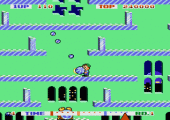
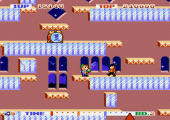
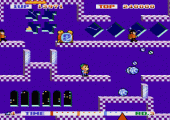
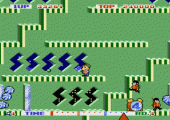
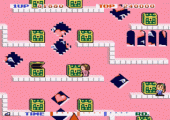
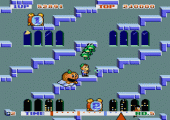
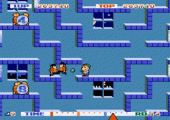
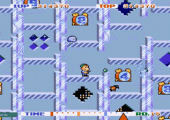

Absolutely addicting. Loved both the arcade original and the Master System version. Just as good and enjoyable as Flicky, too. 8/10.
http://youtu.be/0YALH3sy8wg
well damn